Project Management: TASH Project
VerifiedAdded on 2023/04/24
|18
|3270
|336
AI Summary
This report depicts the crucial significance of using professional project management practices in certain knowledge areas to improve the quality of the nominated project “Training and Apprenticeship Program for the High School Students”.
Contribute Materials
Your contribution can guide someone’s learning journey. Share your
documents today.
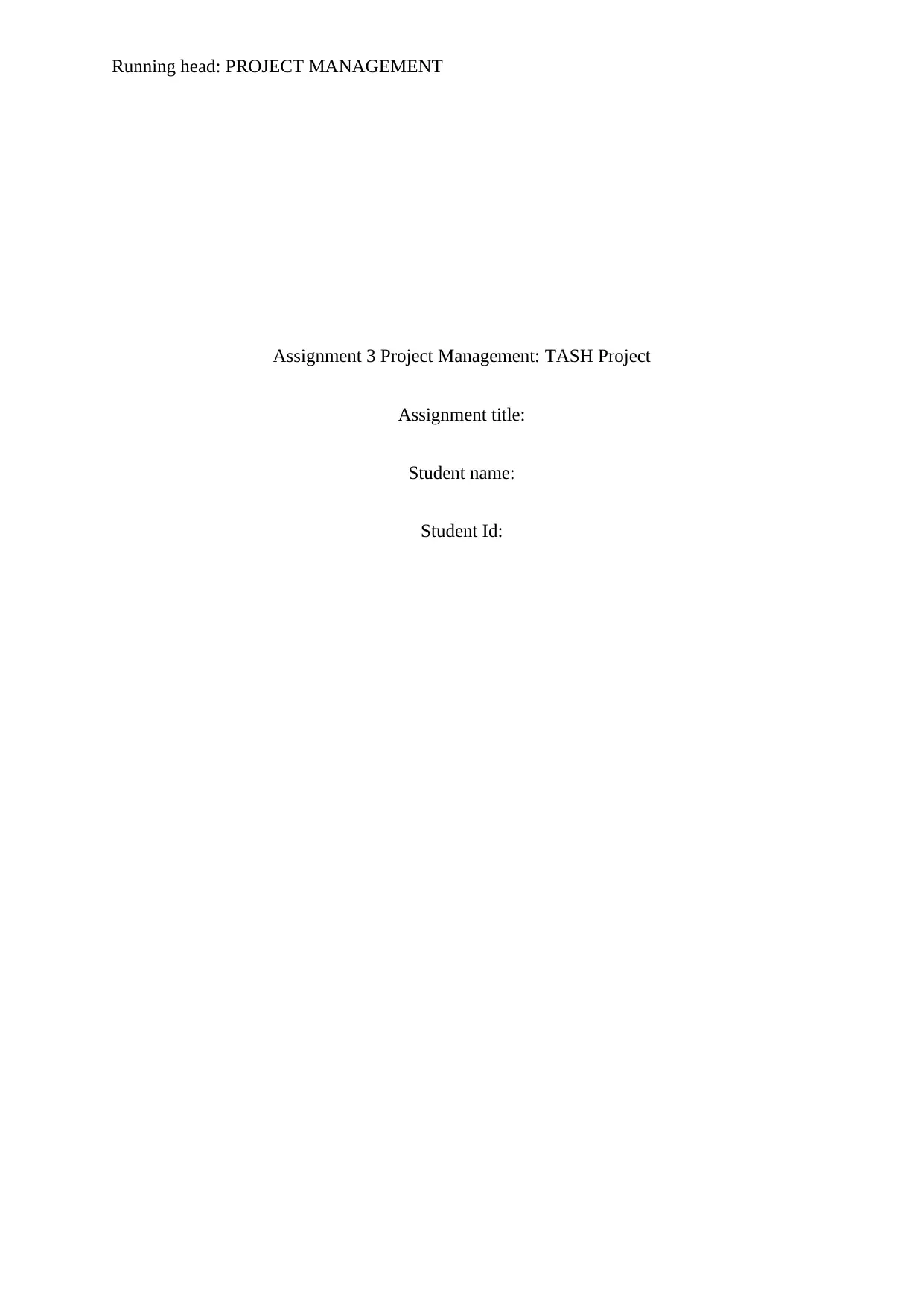
Running head: PROJECT MANAGEMENT
Assignment 3 Project Management: TASH Project
Assignment title:
Student name:
Student Id:
Assignment 3 Project Management: TASH Project
Assignment title:
Student name:
Student Id:
Secure Best Marks with AI Grader
Need help grading? Try our AI Grader for instant feedback on your assignments.

1PROJECT MANAGEMENT
Introduction
This report depicts the crucial significance of using professional project management
practices in certain knowledge areas to improve the quality of the nominated project
“Training and Apprenticeship Program for the High School Students”. Globex is interested
to help the farmers so that they can increase their productivity in terms of precision farming
and arm equipments. Globex has assigned Virtucon to develop a computer based system for
managing the operation and functionalities of TASH project.
Successful implementation of the project will generate collaboration among the
school, farming equipments manufacturers and the Globex representatives. Wide range of
factors such as GPS, Laser, and optical efficiency input cost are inputs to the system which
will deliver strategic solution to the farmers and learners also. The assumptions and
objectives considered for the project are highlighted and elaborated in this project.
Project purpose
The purpose of this project is to design and develop a computer based system to
manage the entire TASH program. The successful implementation of the project will
combine schools, farming equipments manufacturers and the Globex owners. After
comparing performance and skills of the students the training program will be assigned to the
students. It is expected that, successful implementation of the project will help to deliver an
integrated solution for the consumers to improve the business efficiency by reducing the
overall complexity.
Aims
The aim of the project is to design and develop a computer based system for Globex
to collaborate school students, farming equipment manufacturers and precision farming as a
whole. The farming needs of Riverina will completely resolve with the implementation of the
Introduction
This report depicts the crucial significance of using professional project management
practices in certain knowledge areas to improve the quality of the nominated project
“Training and Apprenticeship Program for the High School Students”. Globex is interested
to help the farmers so that they can increase their productivity in terms of precision farming
and arm equipments. Globex has assigned Virtucon to develop a computer based system for
managing the operation and functionalities of TASH project.
Successful implementation of the project will generate collaboration among the
school, farming equipments manufacturers and the Globex representatives. Wide range of
factors such as GPS, Laser, and optical efficiency input cost are inputs to the system which
will deliver strategic solution to the farmers and learners also. The assumptions and
objectives considered for the project are highlighted and elaborated in this project.
Project purpose
The purpose of this project is to design and develop a computer based system to
manage the entire TASH program. The successful implementation of the project will
combine schools, farming equipments manufacturers and the Globex owners. After
comparing performance and skills of the students the training program will be assigned to the
students. It is expected that, successful implementation of the project will help to deliver an
integrated solution for the consumers to improve the business efficiency by reducing the
overall complexity.
Aims
The aim of the project is to design and develop a computer based system for Globex
to collaborate school students, farming equipment manufacturers and precision farming as a
whole. The farming needs of Riverina will completely resolve with the implementation of the
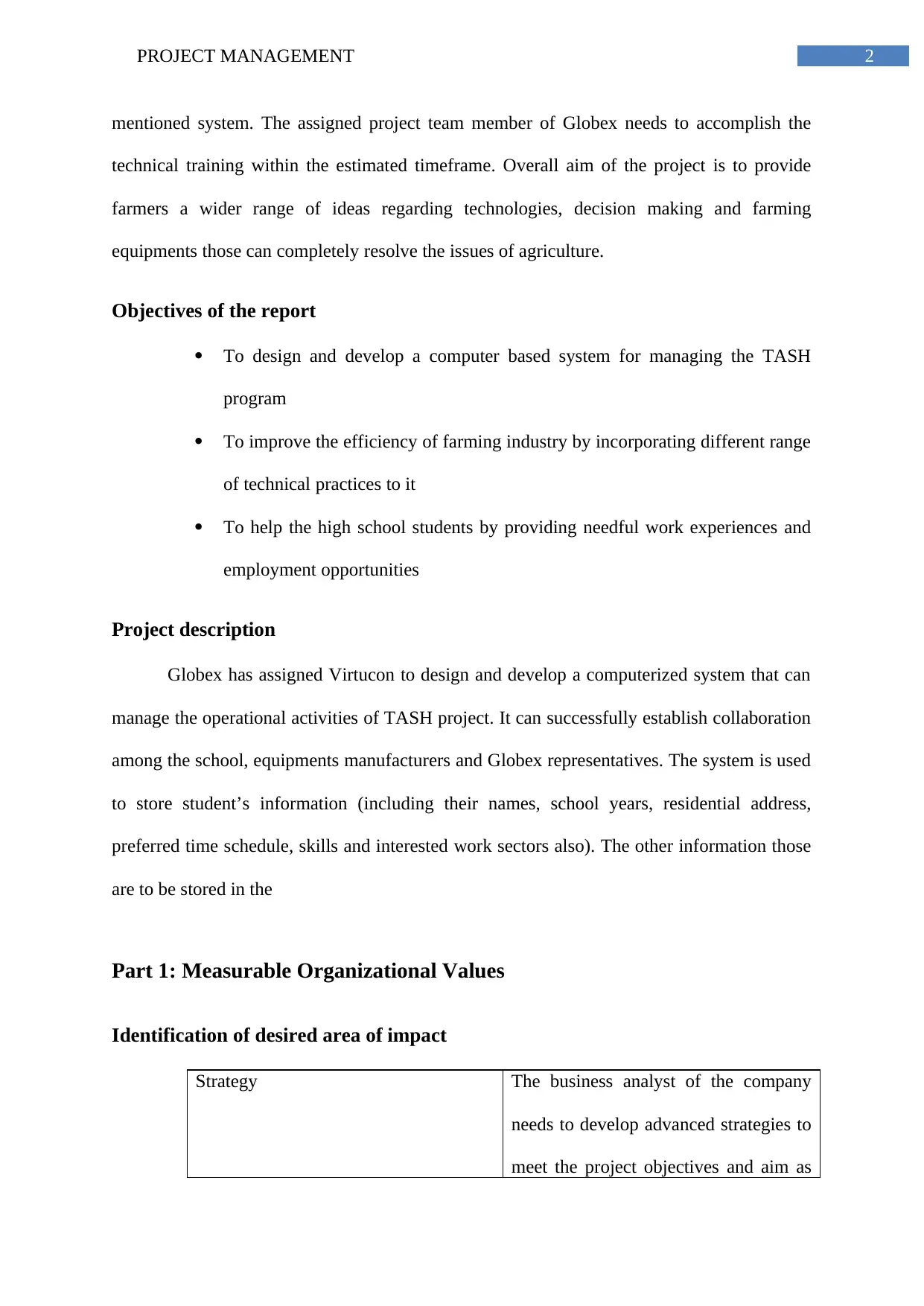
2PROJECT MANAGEMENT
mentioned system. The assigned project team member of Globex needs to accomplish the
technical training within the estimated timeframe. Overall aim of the project is to provide
farmers a wider range of ideas regarding technologies, decision making and farming
equipments those can completely resolve the issues of agriculture.
Objectives of the report
To design and develop a computer based system for managing the TASH
program
To improve the efficiency of farming industry by incorporating different range
of technical practices to it
To help the high school students by providing needful work experiences and
employment opportunities
Project description
Globex has assigned Virtucon to design and develop a computerized system that can
manage the operational activities of TASH project. It can successfully establish collaboration
among the school, equipments manufacturers and Globex representatives. The system is used
to store student’s information (including their names, school years, residential address,
preferred time schedule, skills and interested work sectors also). The other information those
are to be stored in the
Part 1: Measurable Organizational Values
Identification of desired area of impact
Strategy The business analyst of the company
needs to develop advanced strategies to
meet the project objectives and aim as
mentioned system. The assigned project team member of Globex needs to accomplish the
technical training within the estimated timeframe. Overall aim of the project is to provide
farmers a wider range of ideas regarding technologies, decision making and farming
equipments those can completely resolve the issues of agriculture.
Objectives of the report
To design and develop a computer based system for managing the TASH
program
To improve the efficiency of farming industry by incorporating different range
of technical practices to it
To help the high school students by providing needful work experiences and
employment opportunities
Project description
Globex has assigned Virtucon to design and develop a computerized system that can
manage the operational activities of TASH project. It can successfully establish collaboration
among the school, equipments manufacturers and Globex representatives. The system is used
to store student’s information (including their names, school years, residential address,
preferred time schedule, skills and interested work sectors also). The other information those
are to be stored in the
Part 1: Measurable Organizational Values
Identification of desired area of impact
Strategy The business analyst of the company
needs to develop advanced strategies to
meet the project objectives and aim as
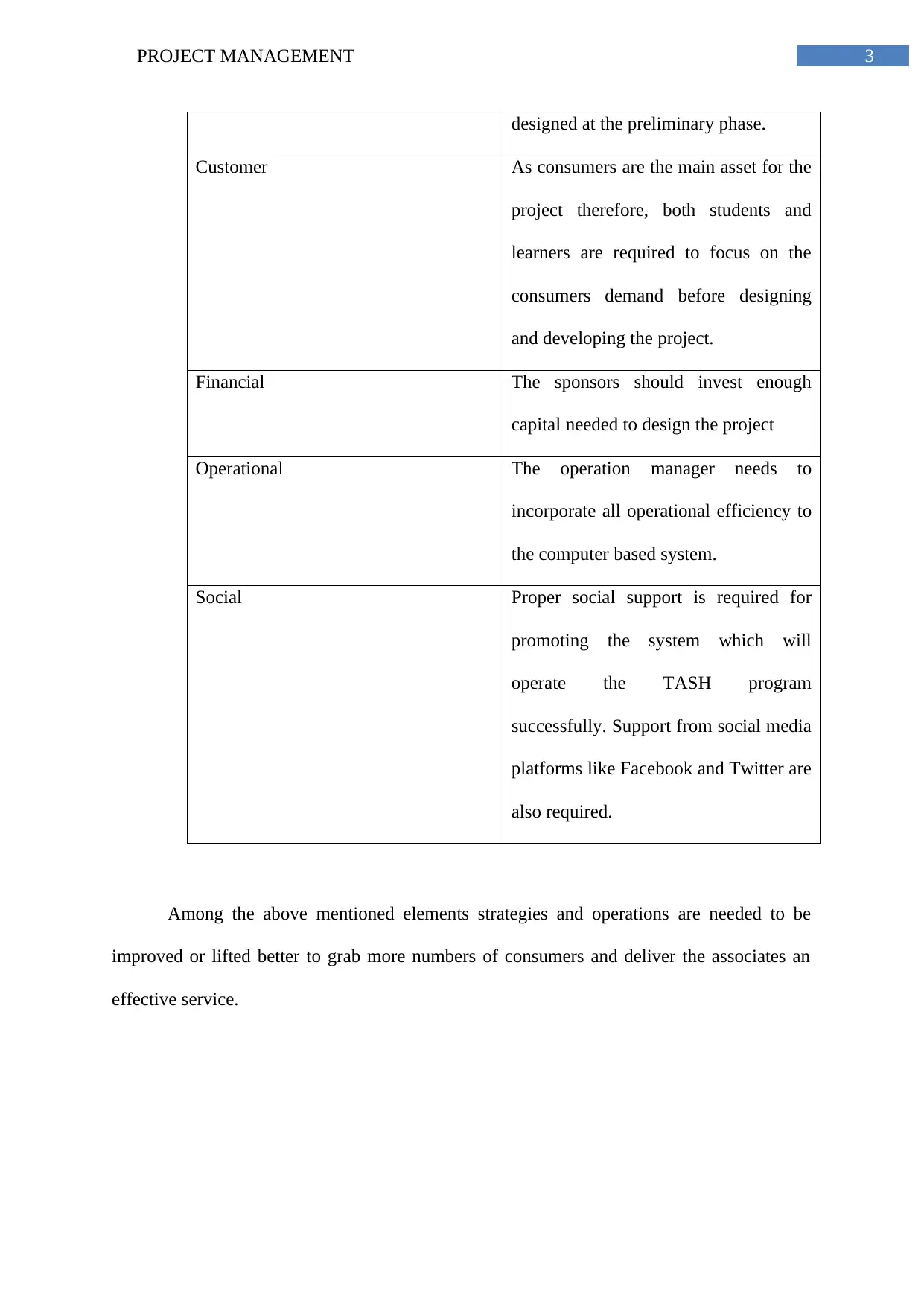
3PROJECT MANAGEMENT
designed at the preliminary phase.
Customer As consumers are the main asset for the
project therefore, both students and
learners are required to focus on the
consumers demand before designing
and developing the project.
Financial The sponsors should invest enough
capital needed to design the project
Operational The operation manager needs to
incorporate all operational efficiency to
the computer based system.
Social Proper social support is required for
promoting the system which will
operate the TASH program
successfully. Support from social media
platforms like Facebook and Twitter are
also required.
Among the above mentioned elements strategies and operations are needed to be
improved or lifted better to grab more numbers of consumers and deliver the associates an
effective service.
designed at the preliminary phase.
Customer As consumers are the main asset for the
project therefore, both students and
learners are required to focus on the
consumers demand before designing
and developing the project.
Financial The sponsors should invest enough
capital needed to design the project
Operational The operation manager needs to
incorporate all operational efficiency to
the computer based system.
Social Proper social support is required for
promoting the system which will
operate the TASH program
successfully. Support from social media
platforms like Facebook and Twitter are
also required.
Among the above mentioned elements strategies and operations are needed to be
improved or lifted better to grab more numbers of consumers and deliver the associates an
effective service.
Paraphrase This Document
Need a fresh take? Get an instant paraphrase of this document with our AI Paraphraser
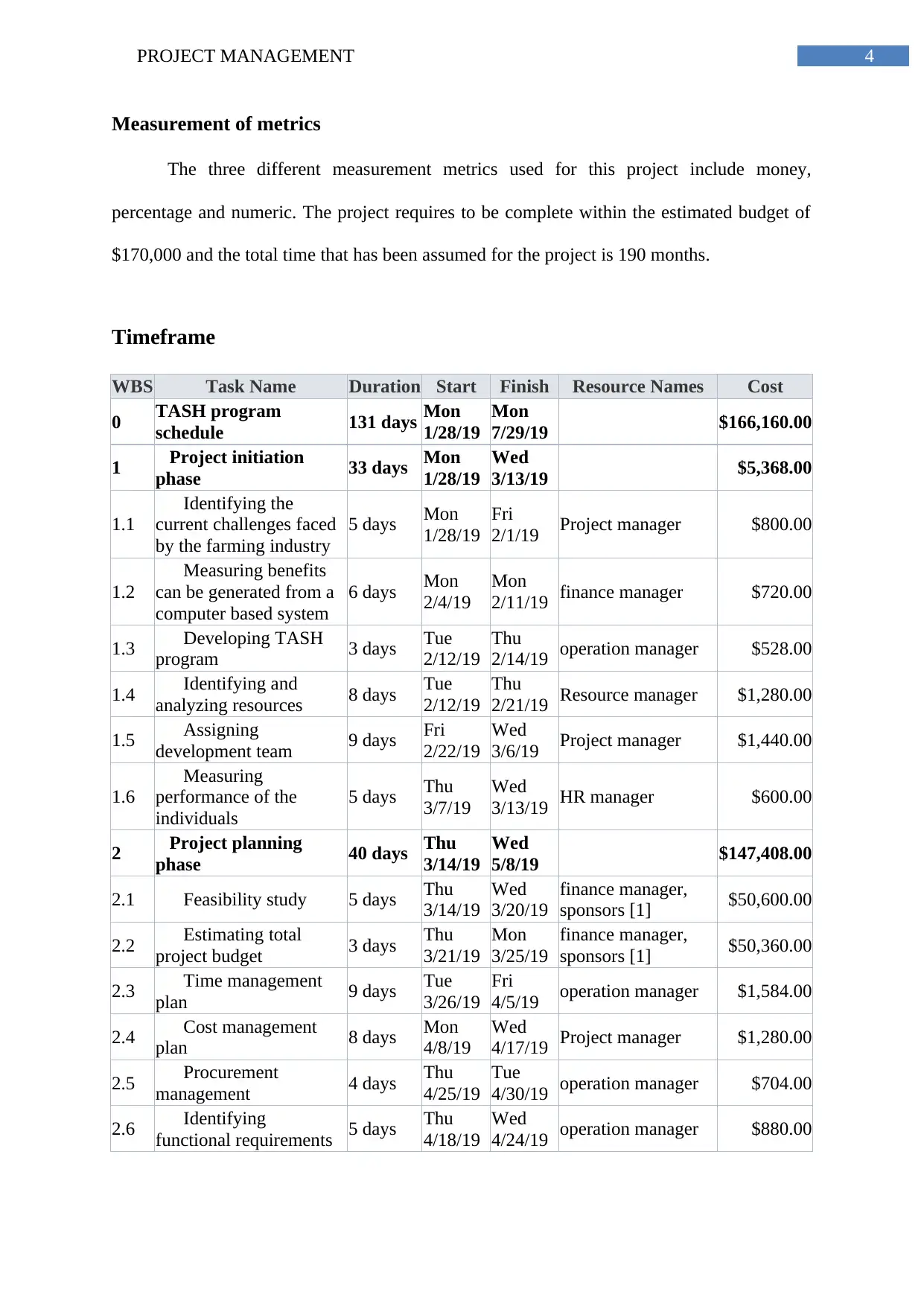
4PROJECT MANAGEMENT
Measurement of metrics
The three different measurement metrics used for this project include money,
percentage and numeric. The project requires to be complete within the estimated budget of
$170,000 and the total time that has been assumed for the project is 190 months.
Timeframe
WBS Task Name Duration Start Finish Resource Names Cost
0 TASH program
schedule 131 days Mon
1/28/19
Mon
7/29/19 $166,160.00
1 Project initiation
phase 33 days Mon
1/28/19
Wed
3/13/19 $5,368.00
1.1
Identifying the
current challenges faced
by the farming industry
5 days Mon
1/28/19
Fri
2/1/19 Project manager $800.00
1.2
Measuring benefits
can be generated from a
computer based system
6 days Mon
2/4/19
Mon
2/11/19 finance manager $720.00
1.3 Developing TASH
program 3 days Tue
2/12/19
Thu
2/14/19 operation manager $528.00
1.4 Identifying and
analyzing resources 8 days Tue
2/12/19
Thu
2/21/19 Resource manager $1,280.00
1.5 Assigning
development team 9 days Fri
2/22/19
Wed
3/6/19 Project manager $1,440.00
1.6
Measuring
performance of the
individuals
5 days Thu
3/7/19
Wed
3/13/19 HR manager $600.00
2 Project planning
phase 40 days Thu
3/14/19
Wed
5/8/19 $147,408.00
2.1 Feasibility study 5 days Thu
3/14/19
Wed
3/20/19
finance manager,
sponsors [1] $50,600.00
2.2 Estimating total
project budget 3 days Thu
3/21/19
Mon
3/25/19
finance manager,
sponsors [1] $50,360.00
2.3 Time management
plan 9 days Tue
3/26/19
Fri
4/5/19 operation manager $1,584.00
2.4 Cost management
plan 8 days Mon
4/8/19
Wed
4/17/19 Project manager $1,280.00
2.5 Procurement
management 4 days Thu
4/25/19
Tue
4/30/19 operation manager $704.00
2.6 Identifying
functional requirements 5 days Thu
4/18/19
Wed
4/24/19 operation manager $880.00
Measurement of metrics
The three different measurement metrics used for this project include money,
percentage and numeric. The project requires to be complete within the estimated budget of
$170,000 and the total time that has been assumed for the project is 190 months.
Timeframe
WBS Task Name Duration Start Finish Resource Names Cost
0 TASH program
schedule 131 days Mon
1/28/19
Mon
7/29/19 $166,160.00
1 Project initiation
phase 33 days Mon
1/28/19
Wed
3/13/19 $5,368.00
1.1
Identifying the
current challenges faced
by the farming industry
5 days Mon
1/28/19
Fri
2/1/19 Project manager $800.00
1.2
Measuring benefits
can be generated from a
computer based system
6 days Mon
2/4/19
Mon
2/11/19 finance manager $720.00
1.3 Developing TASH
program 3 days Tue
2/12/19
Thu
2/14/19 operation manager $528.00
1.4 Identifying and
analyzing resources 8 days Tue
2/12/19
Thu
2/21/19 Resource manager $1,280.00
1.5 Assigning
development team 9 days Fri
2/22/19
Wed
3/6/19 Project manager $1,440.00
1.6
Measuring
performance of the
individuals
5 days Thu
3/7/19
Wed
3/13/19 HR manager $600.00
2 Project planning
phase 40 days Thu
3/14/19
Wed
5/8/19 $147,408.00
2.1 Feasibility study 5 days Thu
3/14/19
Wed
3/20/19
finance manager,
sponsors [1] $50,600.00
2.2 Estimating total
project budget 3 days Thu
3/21/19
Mon
3/25/19
finance manager,
sponsors [1] $50,360.00
2.3 Time management
plan 9 days Tue
3/26/19
Fri
4/5/19 operation manager $1,584.00
2.4 Cost management
plan 8 days Mon
4/8/19
Wed
4/17/19 Project manager $1,280.00
2.5 Procurement
management 4 days Thu
4/25/19
Tue
4/30/19 operation manager $704.00
2.6 Identifying
functional requirements 5 days Thu
4/18/19
Wed
4/24/19 operation manager $880.00
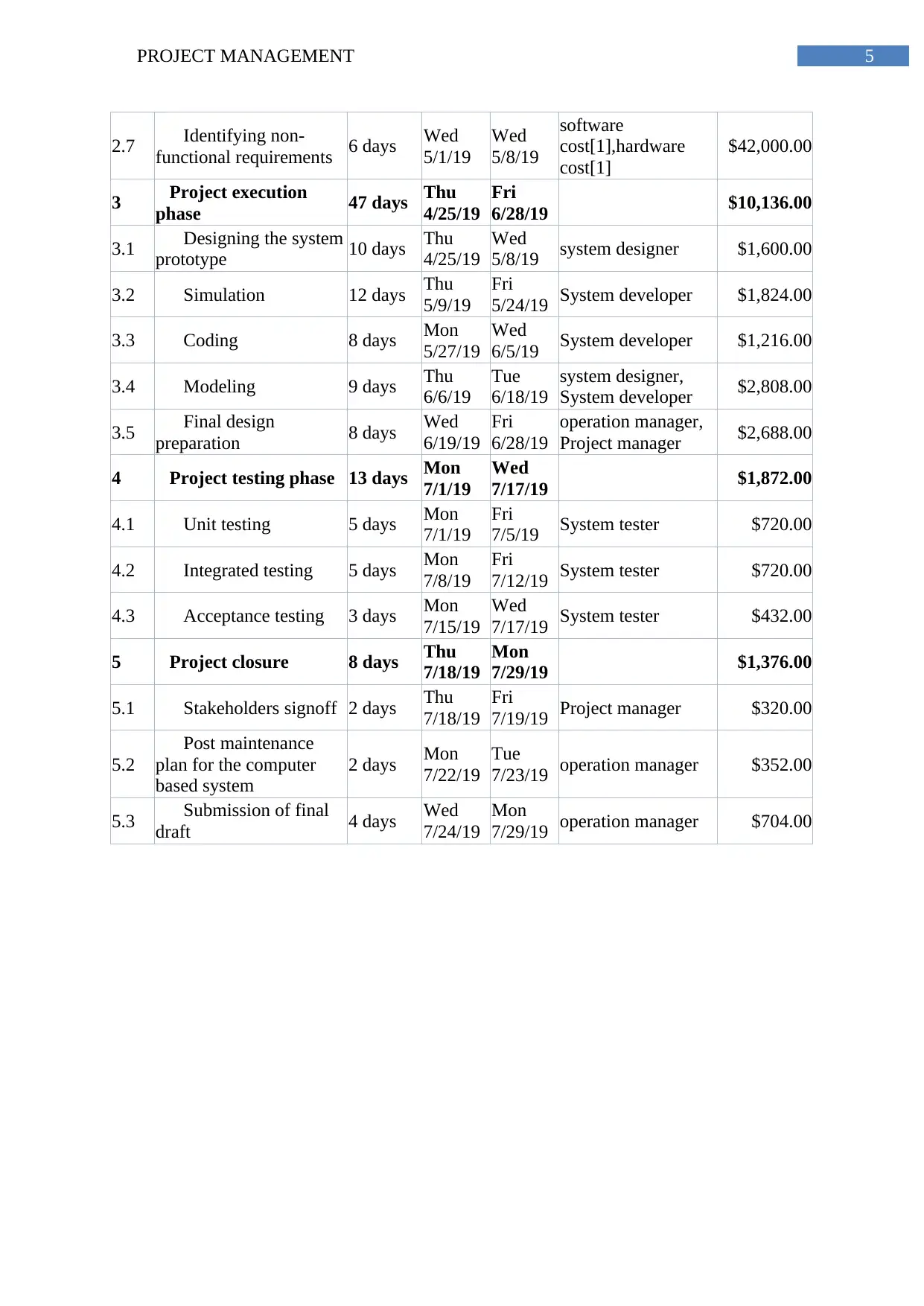
5PROJECT MANAGEMENT
2.7 Identifying non-
functional requirements 6 days Wed
5/1/19
Wed
5/8/19
software
cost[1],hardware
cost[1]
$42,000.00
3 Project execution
phase 47 days Thu
4/25/19
Fri
6/28/19 $10,136.00
3.1 Designing the system
prototype 10 days Thu
4/25/19
Wed
5/8/19 system designer $1,600.00
3.2 Simulation 12 days Thu
5/9/19
Fri
5/24/19 System developer $1,824.00
3.3 Coding 8 days Mon
5/27/19
Wed
6/5/19 System developer $1,216.00
3.4 Modeling 9 days Thu
6/6/19
Tue
6/18/19
system designer,
System developer $2,808.00
3.5 Final design
preparation 8 days Wed
6/19/19
Fri
6/28/19
operation manager,
Project manager $2,688.00
4 Project testing phase 13 days Mon
7/1/19
Wed
7/17/19 $1,872.00
4.1 Unit testing 5 days Mon
7/1/19
Fri
7/5/19 System tester $720.00
4.2 Integrated testing 5 days Mon
7/8/19
Fri
7/12/19 System tester $720.00
4.3 Acceptance testing 3 days Mon
7/15/19
Wed
7/17/19 System tester $432.00
5 Project closure 8 days Thu
7/18/19
Mon
7/29/19 $1,376.00
5.1 Stakeholders signoff 2 days Thu
7/18/19
Fri
7/19/19 Project manager $320.00
5.2
Post maintenance
plan for the computer
based system
2 days Mon
7/22/19
Tue
7/23/19 operation manager $352.00
5.3 Submission of final
draft 4 days Wed
7/24/19
Mon
7/29/19 operation manager $704.00
2.7 Identifying non-
functional requirements 6 days Wed
5/1/19
Wed
5/8/19
software
cost[1],hardware
cost[1]
$42,000.00
3 Project execution
phase 47 days Thu
4/25/19
Fri
6/28/19 $10,136.00
3.1 Designing the system
prototype 10 days Thu
4/25/19
Wed
5/8/19 system designer $1,600.00
3.2 Simulation 12 days Thu
5/9/19
Fri
5/24/19 System developer $1,824.00
3.3 Coding 8 days Mon
5/27/19
Wed
6/5/19 System developer $1,216.00
3.4 Modeling 9 days Thu
6/6/19
Tue
6/18/19
system designer,
System developer $2,808.00
3.5 Final design
preparation 8 days Wed
6/19/19
Fri
6/28/19
operation manager,
Project manager $2,688.00
4 Project testing phase 13 days Mon
7/1/19
Wed
7/17/19 $1,872.00
4.1 Unit testing 5 days Mon
7/1/19
Fri
7/5/19 System tester $720.00
4.2 Integrated testing 5 days Mon
7/8/19
Fri
7/12/19 System tester $720.00
4.3 Acceptance testing 3 days Mon
7/15/19
Wed
7/17/19 System tester $432.00
5 Project closure 8 days Thu
7/18/19
Mon
7/29/19 $1,376.00
5.1 Stakeholders signoff 2 days Thu
7/18/19
Fri
7/19/19 Project manager $320.00
5.2
Post maintenance
plan for the computer
based system
2 days Mon
7/22/19
Tue
7/23/19 operation manager $352.00
5.3 Submission of final
draft 4 days Wed
7/24/19
Mon
7/29/19 operation manager $704.00

6PROJECT MANAGEMENT
Figure 1: Gantt chart for the project
(Sources: Created by author)
Part 2: Scope
Scope of the project
The scope of the project is to design and develop a computer based system for
managing the TASH program developed for the students. It is assumed that with the
successful delivery of the project Globex will be able to spread security awareness among the
associates, farmers and students. The course details are also stored in the server. Not only this
but also, after comparing the skills and knowledge of students the needful training courses for
the students assigned. The focus of Globex is to help the farmers by enhancing their
Figure 1: Gantt chart for the project
(Sources: Created by author)
Part 2: Scope
Scope of the project
The scope of the project is to design and develop a computer based system for
managing the TASH program developed for the students. It is assumed that with the
successful delivery of the project Globex will be able to spread security awareness among the
associates, farmers and students. The course details are also stored in the server. Not only this
but also, after comparing the skills and knowledge of students the needful training courses for
the students assigned. The focus of Globex is to help the farmers by enhancing their
Secure Best Marks with AI Grader
Need help grading? Try our AI Grader for instant feedback on your assignments.
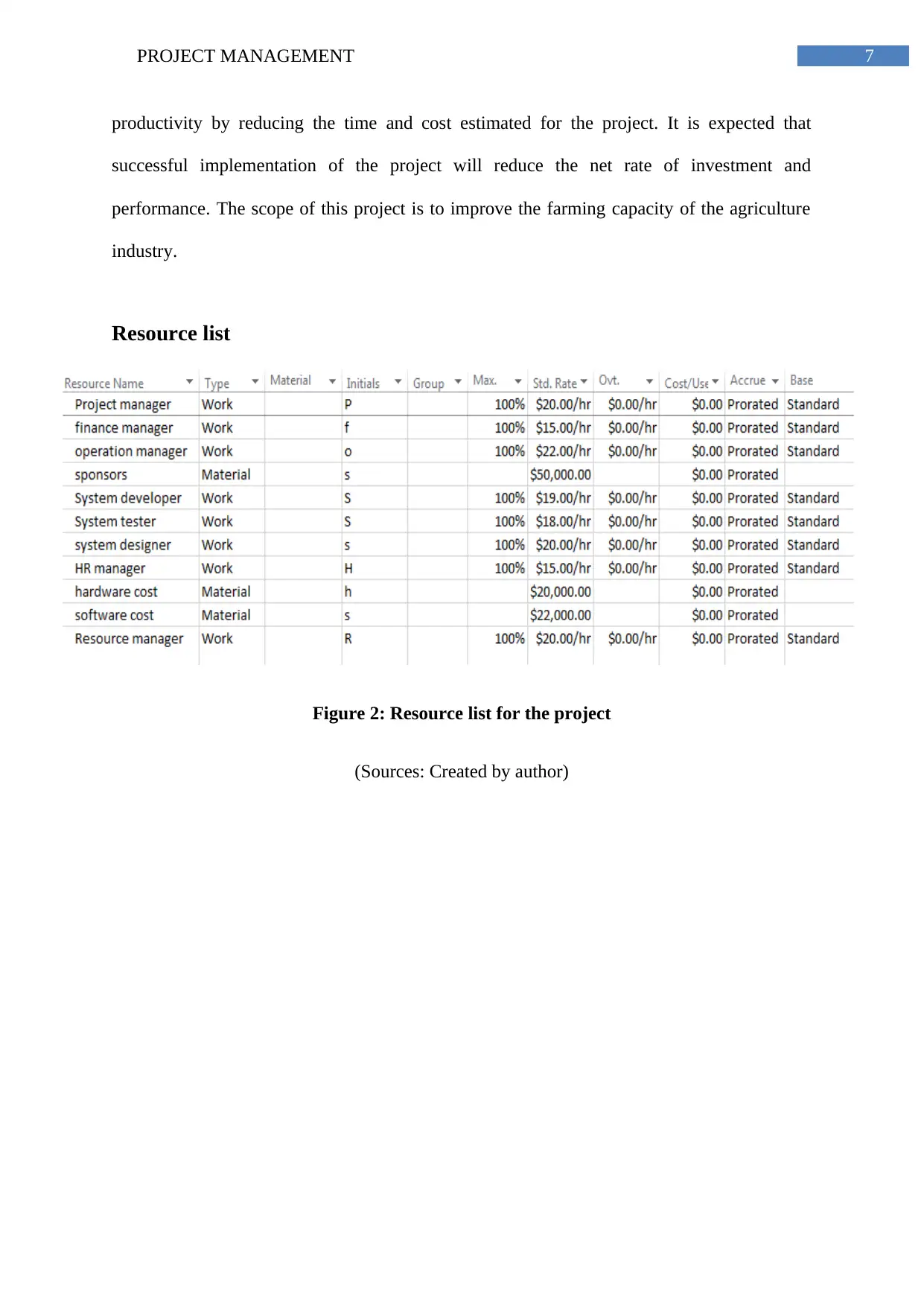
7PROJECT MANAGEMENT
productivity by reducing the time and cost estimated for the project. It is expected that
successful implementation of the project will reduce the net rate of investment and
performance. The scope of this project is to improve the farming capacity of the agriculture
industry.
Resource list
Figure 2: Resource list for the project
(Sources: Created by author)
productivity by reducing the time and cost estimated for the project. It is expected that
successful implementation of the project will reduce the net rate of investment and
performance. The scope of this project is to improve the farming capacity of the agriculture
industry.
Resource list
Figure 2: Resource list for the project
(Sources: Created by author)

8PROJECT MANAGEMENT
Part 3: Work Breakdown Structure
Preparation of a WBS
TASH program schedule
Project initiation phase
Identifying the current
challenges faced by
the farming industry
Measuring benefits
can be generated
from a computer
based system
Developing TASH
program
Identifying and
analyzing resources
Assigning
development team
Measuring
performance of the
individuals
Project planning phase
Feasibility study
Estimating total
project budget
Time management
plan
Cost management
plan
Procurement
management
Identifying
functional
requirements
Identifying
non-functional
requirements
Project execution phase
Designing the
system prototype
Simulation
Coding
Modeling
Final design
preparation
Project testing phase
Unit testing
Integrated testing
Acceptance testing
Project closure
Stakeholders signoff
Post maintenance
plan for the
computer based
system
Submission of final
draft
Figure 3: WBS for the project
(Sources: Created by author)
WBS Task Name Duration Resource Names Cost
0 TASH program schedule 131
days $166,160.00
1 Project initiation phase 33 days $5,368.00
1.1 Identifying the current challenges
faced by the farming industry 5 days Project manager $800.00
1.2
Measuring benefits can be
generated from a computer based
system
6 days finance manager $720.00
1.3 Developing TASH program 3 days operation manager $528.00
1.4 Identifying and analyzing resources 8 days Resource manager $1,280.00
1.5 Assigning development team 9 days Project manager $1,440.00
1.6 Measuring performance of the
individuals 5 days HR manager $600.00
2 Project planning phase 40 days $147,408.00
2.1 Feasibility study 5 days finance manager,sponsors
[1] $50,600.00
2.2 Estimating total project budget 3 days finance manager,sponsors $50,360.00
Part 3: Work Breakdown Structure
Preparation of a WBS
TASH program schedule
Project initiation phase
Identifying the current
challenges faced by
the farming industry
Measuring benefits
can be generated
from a computer
based system
Developing TASH
program
Identifying and
analyzing resources
Assigning
development team
Measuring
performance of the
individuals
Project planning phase
Feasibility study
Estimating total
project budget
Time management
plan
Cost management
plan
Procurement
management
Identifying
functional
requirements
Identifying
non-functional
requirements
Project execution phase
Designing the
system prototype
Simulation
Coding
Modeling
Final design
preparation
Project testing phase
Unit testing
Integrated testing
Acceptance testing
Project closure
Stakeholders signoff
Post maintenance
plan for the
computer based
system
Submission of final
draft
Figure 3: WBS for the project
(Sources: Created by author)
WBS Task Name Duration Resource Names Cost
0 TASH program schedule 131
days $166,160.00
1 Project initiation phase 33 days $5,368.00
1.1 Identifying the current challenges
faced by the farming industry 5 days Project manager $800.00
1.2
Measuring benefits can be
generated from a computer based
system
6 days finance manager $720.00
1.3 Developing TASH program 3 days operation manager $528.00
1.4 Identifying and analyzing resources 8 days Resource manager $1,280.00
1.5 Assigning development team 9 days Project manager $1,440.00
1.6 Measuring performance of the
individuals 5 days HR manager $600.00
2 Project planning phase 40 days $147,408.00
2.1 Feasibility study 5 days finance manager,sponsors
[1] $50,600.00
2.2 Estimating total project budget 3 days finance manager,sponsors $50,360.00
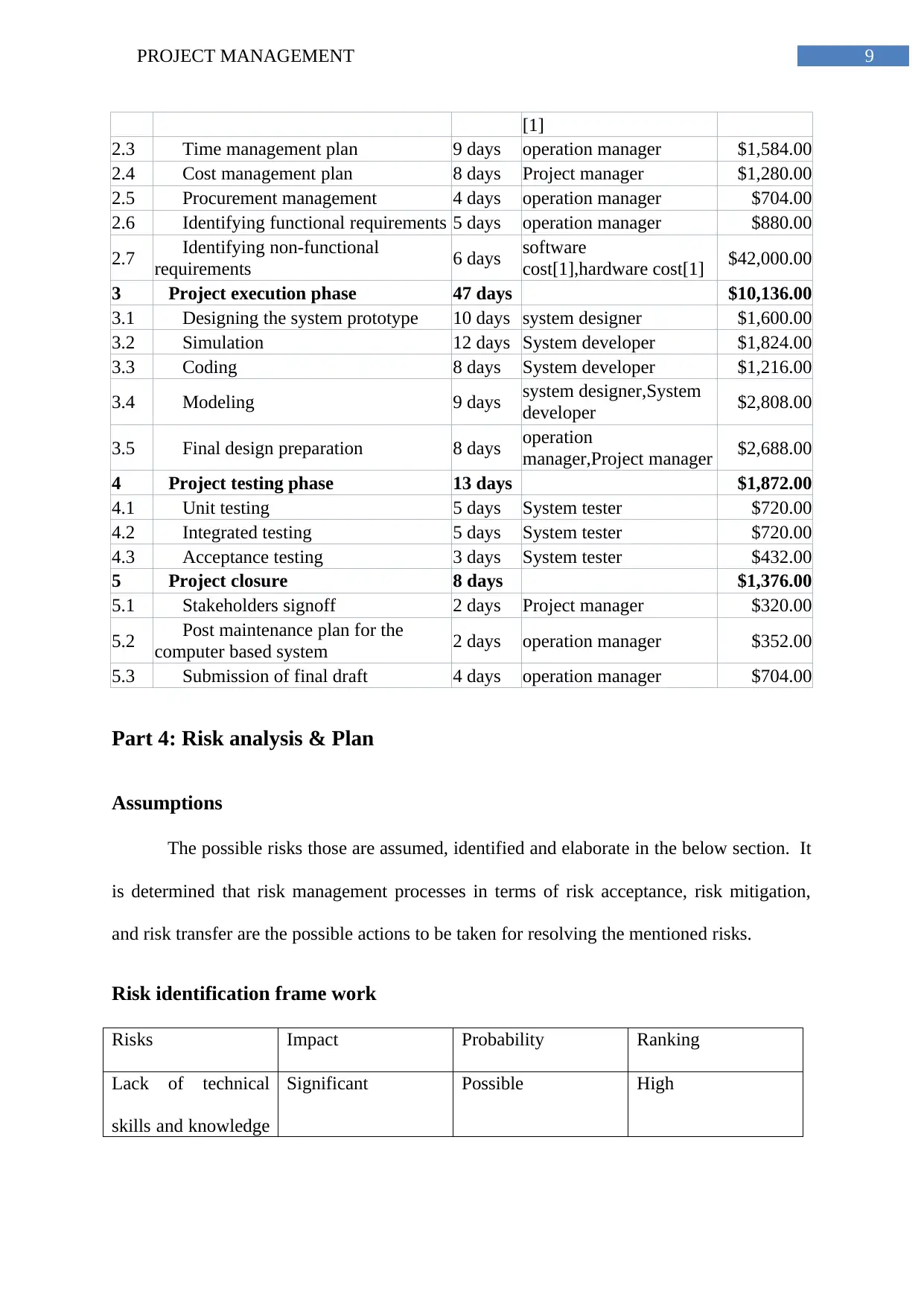
9PROJECT MANAGEMENT
[1]
2.3 Time management plan 9 days operation manager $1,584.00
2.4 Cost management plan 8 days Project manager $1,280.00
2.5 Procurement management 4 days operation manager $704.00
2.6 Identifying functional requirements 5 days operation manager $880.00
2.7 Identifying non-functional
requirements 6 days software
cost[1],hardware cost[1] $42,000.00
3 Project execution phase 47 days $10,136.00
3.1 Designing the system prototype 10 days system designer $1,600.00
3.2 Simulation 12 days System developer $1,824.00
3.3 Coding 8 days System developer $1,216.00
3.4 Modeling 9 days system designer,System
developer $2,808.00
3.5 Final design preparation 8 days operation
manager,Project manager $2,688.00
4 Project testing phase 13 days $1,872.00
4.1 Unit testing 5 days System tester $720.00
4.2 Integrated testing 5 days System tester $720.00
4.3 Acceptance testing 3 days System tester $432.00
5 Project closure 8 days $1,376.00
5.1 Stakeholders signoff 2 days Project manager $320.00
5.2 Post maintenance plan for the
computer based system 2 days operation manager $352.00
5.3 Submission of final draft 4 days operation manager $704.00
Part 4: Risk analysis & Plan
Assumptions
The possible risks those are assumed, identified and elaborate in the below section. It
is determined that risk management processes in terms of risk acceptance, risk mitigation,
and risk transfer are the possible actions to be taken for resolving the mentioned risks.
Risk identification frame work
Risks Impact Probability Ranking
Lack of technical
skills and knowledge
Significant Possible High
[1]
2.3 Time management plan 9 days operation manager $1,584.00
2.4 Cost management plan 8 days Project manager $1,280.00
2.5 Procurement management 4 days operation manager $704.00
2.6 Identifying functional requirements 5 days operation manager $880.00
2.7 Identifying non-functional
requirements 6 days software
cost[1],hardware cost[1] $42,000.00
3 Project execution phase 47 days $10,136.00
3.1 Designing the system prototype 10 days system designer $1,600.00
3.2 Simulation 12 days System developer $1,824.00
3.3 Coding 8 days System developer $1,216.00
3.4 Modeling 9 days system designer,System
developer $2,808.00
3.5 Final design preparation 8 days operation
manager,Project manager $2,688.00
4 Project testing phase 13 days $1,872.00
4.1 Unit testing 5 days System tester $720.00
4.2 Integrated testing 5 days System tester $720.00
4.3 Acceptance testing 3 days System tester $432.00
5 Project closure 8 days $1,376.00
5.1 Stakeholders signoff 2 days Project manager $320.00
5.2 Post maintenance plan for the
computer based system 2 days operation manager $352.00
5.3 Submission of final draft 4 days operation manager $704.00
Part 4: Risk analysis & Plan
Assumptions
The possible risks those are assumed, identified and elaborate in the below section. It
is determined that risk management processes in terms of risk acceptance, risk mitigation,
and risk transfer are the possible actions to be taken for resolving the mentioned risks.
Risk identification frame work
Risks Impact Probability Ranking
Lack of technical
skills and knowledge
Significant Possible High
Paraphrase This Document
Need a fresh take? Get an instant paraphrase of this document with our AI Paraphraser
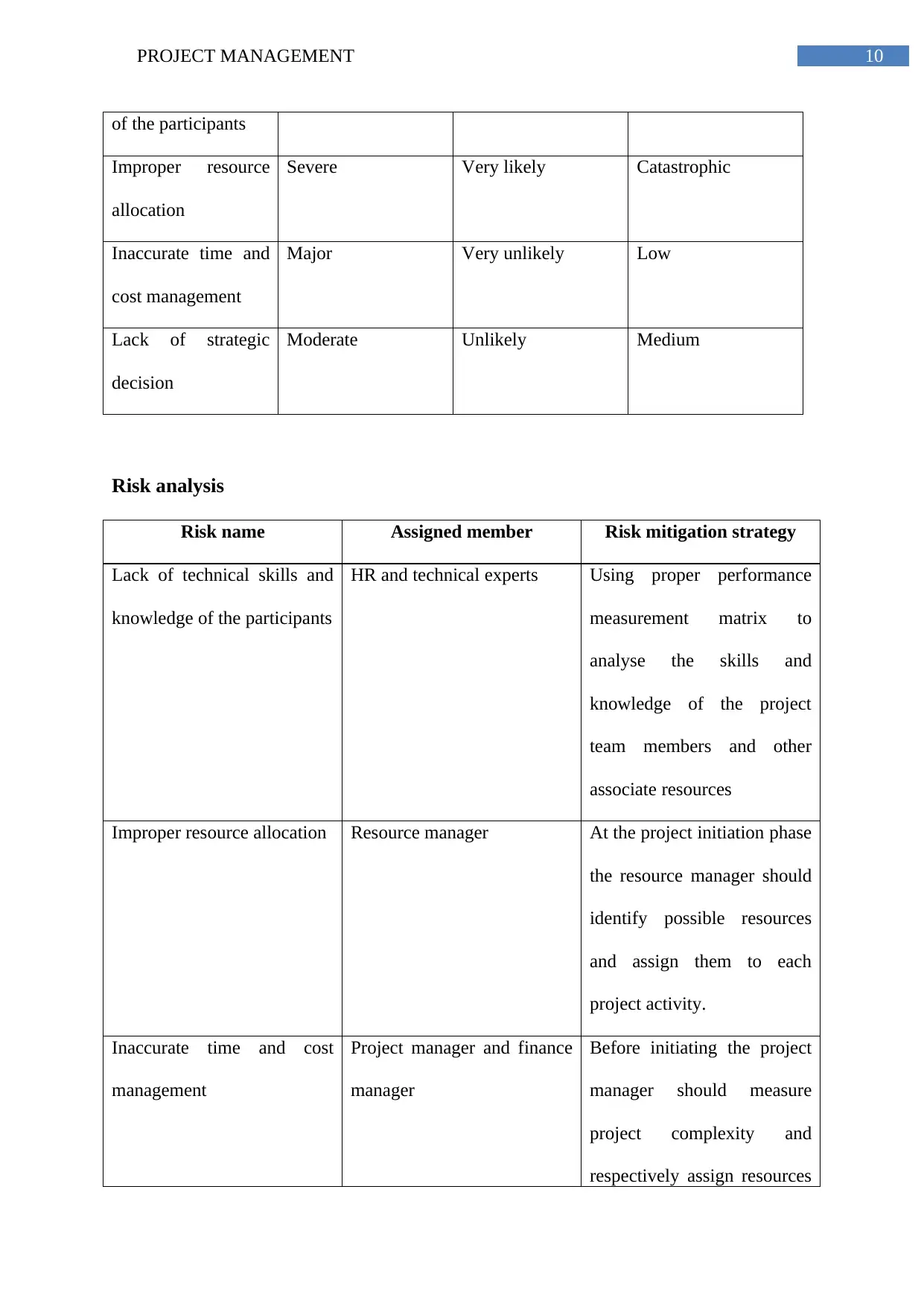
10PROJECT MANAGEMENT
of the participants
Improper resource
allocation
Severe Very likely Catastrophic
Inaccurate time and
cost management
Major Very unlikely Low
Lack of strategic
decision
Moderate Unlikely Medium
Risk analysis
Risk name Assigned member Risk mitigation strategy
Lack of technical skills and
knowledge of the participants
HR and technical experts Using proper performance
measurement matrix to
analyse the skills and
knowledge of the project
team members and other
associate resources
Improper resource allocation Resource manager At the project initiation phase
the resource manager should
identify possible resources
and assign them to each
project activity.
Inaccurate time and cost
management
Project manager and finance
manager
Before initiating the project
manager should measure
project complexity and
respectively assign resources
of the participants
Improper resource
allocation
Severe Very likely Catastrophic
Inaccurate time and
cost management
Major Very unlikely Low
Lack of strategic
decision
Moderate Unlikely Medium
Risk analysis
Risk name Assigned member Risk mitigation strategy
Lack of technical skills and
knowledge of the participants
HR and technical experts Using proper performance
measurement matrix to
analyse the skills and
knowledge of the project
team members and other
associate resources
Improper resource allocation Resource manager At the project initiation phase
the resource manager should
identify possible resources
and assign them to each
project activity.
Inaccurate time and cost
management
Project manager and finance
manager
Before initiating the project
manager should measure
project complexity and
respectively assign resources
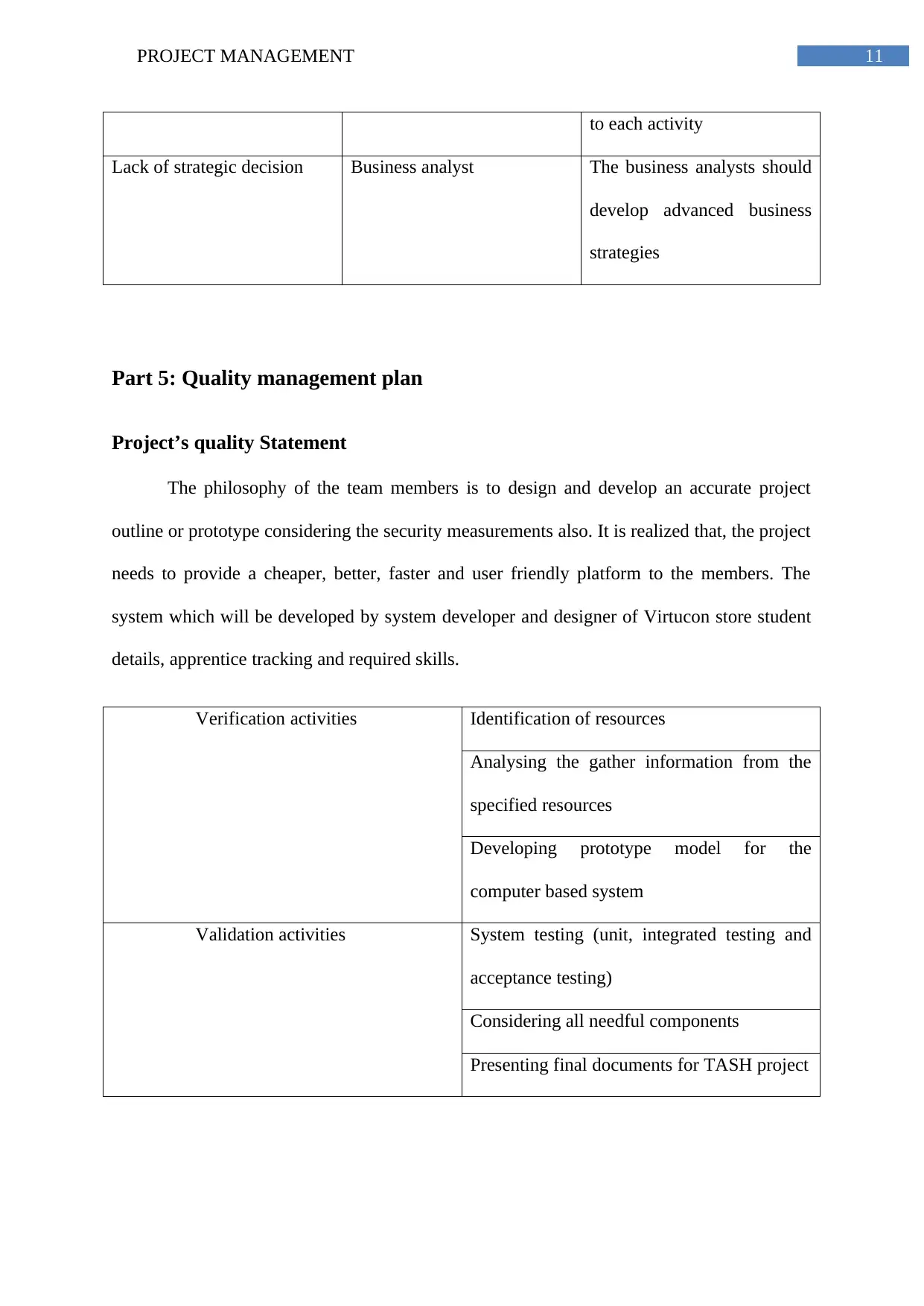
11PROJECT MANAGEMENT
to each activity
Lack of strategic decision Business analyst The business analysts should
develop advanced business
strategies
Part 5: Quality management plan
Project’s quality Statement
The philosophy of the team members is to design and develop an accurate project
outline or prototype considering the security measurements also. It is realized that, the project
needs to provide a cheaper, better, faster and user friendly platform to the members. The
system which will be developed by system developer and designer of Virtucon store student
details, apprentice tracking and required skills.
Verification activities Identification of resources
Analysing the gather information from the
specified resources
Developing prototype model for the
computer based system
Validation activities System testing (unit, integrated testing and
acceptance testing)
Considering all needful components
Presenting final documents for TASH project
to each activity
Lack of strategic decision Business analyst The business analysts should
develop advanced business
strategies
Part 5: Quality management plan
Project’s quality Statement
The philosophy of the team members is to design and develop an accurate project
outline or prototype considering the security measurements also. It is realized that, the project
needs to provide a cheaper, better, faster and user friendly platform to the members. The
system which will be developed by system developer and designer of Virtucon store student
details, apprentice tracking and required skills.
Verification activities Identification of resources
Analysing the gather information from the
specified resources
Developing prototype model for the
computer based system
Validation activities System testing (unit, integrated testing and
acceptance testing)
Considering all needful components
Presenting final documents for TASH project
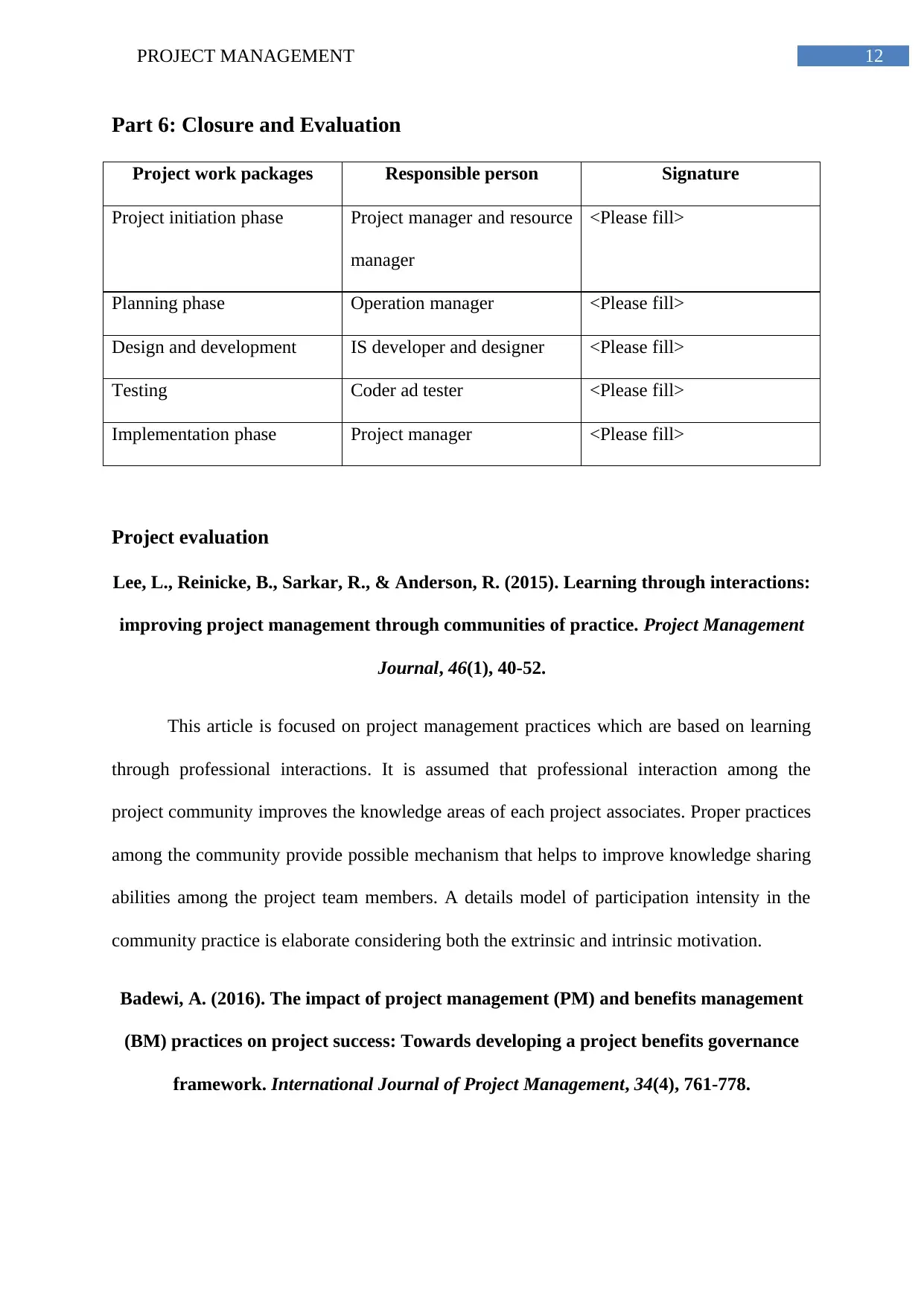
12PROJECT MANAGEMENT
Part 6: Closure and Evaluation
Project work packages Responsible person Signature
Project initiation phase Project manager and resource
manager
<Please fill>
Planning phase Operation manager <Please fill>
Design and development IS developer and designer <Please fill>
Testing Coder ad tester <Please fill>
Implementation phase Project manager <Please fill>
Project evaluation
Lee, L., Reinicke, B., Sarkar, R., & Anderson, R. (2015). Learning through interactions:
improving project management through communities of practice. Project Management
Journal, 46(1), 40-52.
This article is focused on project management practices which are based on learning
through professional interactions. It is assumed that professional interaction among the
project community improves the knowledge areas of each project associates. Proper practices
among the community provide possible mechanism that helps to improve knowledge sharing
abilities among the project team members. A details model of participation intensity in the
community practice is elaborate considering both the extrinsic and intrinsic motivation.
Badewi, A. (2016). The impact of project management (PM) and benefits management
(BM) practices on project success: Towards developing a project benefits governance
framework. International Journal of Project Management, 34(4), 761-778.
Part 6: Closure and Evaluation
Project work packages Responsible person Signature
Project initiation phase Project manager and resource
manager
<Please fill>
Planning phase Operation manager <Please fill>
Design and development IS developer and designer <Please fill>
Testing Coder ad tester <Please fill>
Implementation phase Project manager <Please fill>
Project evaluation
Lee, L., Reinicke, B., Sarkar, R., & Anderson, R. (2015). Learning through interactions:
improving project management through communities of practice. Project Management
Journal, 46(1), 40-52.
This article is focused on project management practices which are based on learning
through professional interactions. It is assumed that professional interaction among the
project community improves the knowledge areas of each project associates. Proper practices
among the community provide possible mechanism that helps to improve knowledge sharing
abilities among the project team members. A details model of participation intensity in the
community practice is elaborate considering both the extrinsic and intrinsic motivation.
Badewi, A. (2016). The impact of project management (PM) and benefits management
(BM) practices on project success: Towards developing a project benefits governance
framework. International Journal of Project Management, 34(4), 761-778.
Secure Best Marks with AI Grader
Need help grading? Try our AI Grader for instant feedback on your assignments.
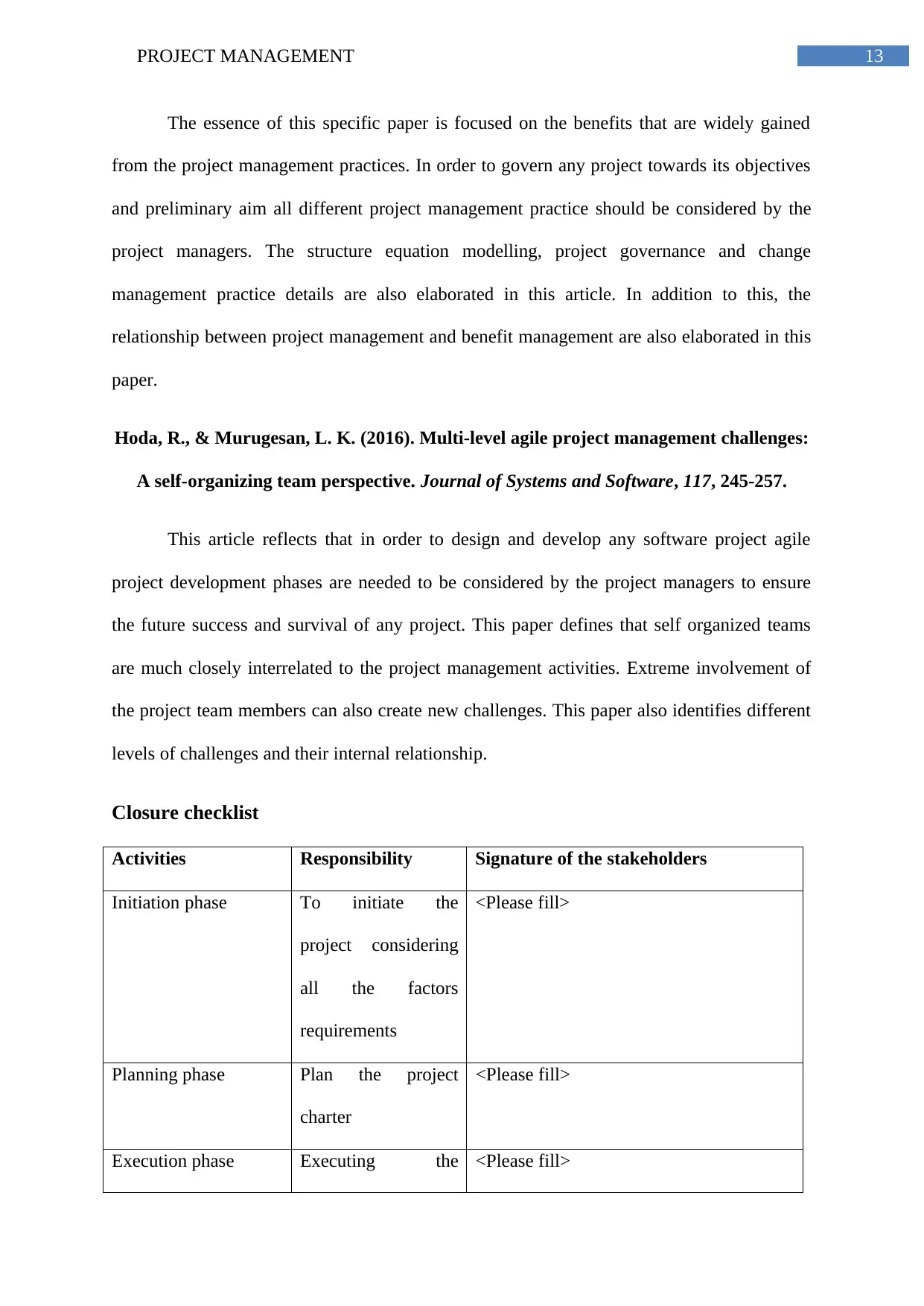
13PROJECT MANAGEMENT
The essence of this specific paper is focused on the benefits that are widely gained
from the project management practices. In order to govern any project towards its objectives
and preliminary aim all different project management practice should be considered by the
project managers. The structure equation modelling, project governance and change
management practice details are also elaborated in this article. In addition to this, the
relationship between project management and benefit management are also elaborated in this
paper.
Hoda, R., & Murugesan, L. K. (2016). Multi-level agile project management challenges:
A self-organizing team perspective. Journal of Systems and Software, 117, 245-257.
This article reflects that in order to design and develop any software project agile
project development phases are needed to be considered by the project managers to ensure
the future success and survival of any project. This paper defines that self organized teams
are much closely interrelated to the project management activities. Extreme involvement of
the project team members can also create new challenges. This paper also identifies different
levels of challenges and their internal relationship.
Closure checklist
Activities Responsibility Signature of the stakeholders
Initiation phase To initiate the
project considering
all the factors
requirements
<Please fill>
Planning phase Plan the project
charter
<Please fill>
Execution phase Executing the <Please fill>
The essence of this specific paper is focused on the benefits that are widely gained
from the project management practices. In order to govern any project towards its objectives
and preliminary aim all different project management practice should be considered by the
project managers. The structure equation modelling, project governance and change
management practice details are also elaborated in this article. In addition to this, the
relationship between project management and benefit management are also elaborated in this
paper.
Hoda, R., & Murugesan, L. K. (2016). Multi-level agile project management challenges:
A self-organizing team perspective. Journal of Systems and Software, 117, 245-257.
This article reflects that in order to design and develop any software project agile
project development phases are needed to be considered by the project managers to ensure
the future success and survival of any project. This paper defines that self organized teams
are much closely interrelated to the project management activities. Extreme involvement of
the project team members can also create new challenges. This paper also identifies different
levels of challenges and their internal relationship.
Closure checklist
Activities Responsibility Signature of the stakeholders
Initiation phase To initiate the
project considering
all the factors
requirements
<Please fill>
Planning phase Plan the project
charter
<Please fill>
Execution phase Executing the <Please fill>
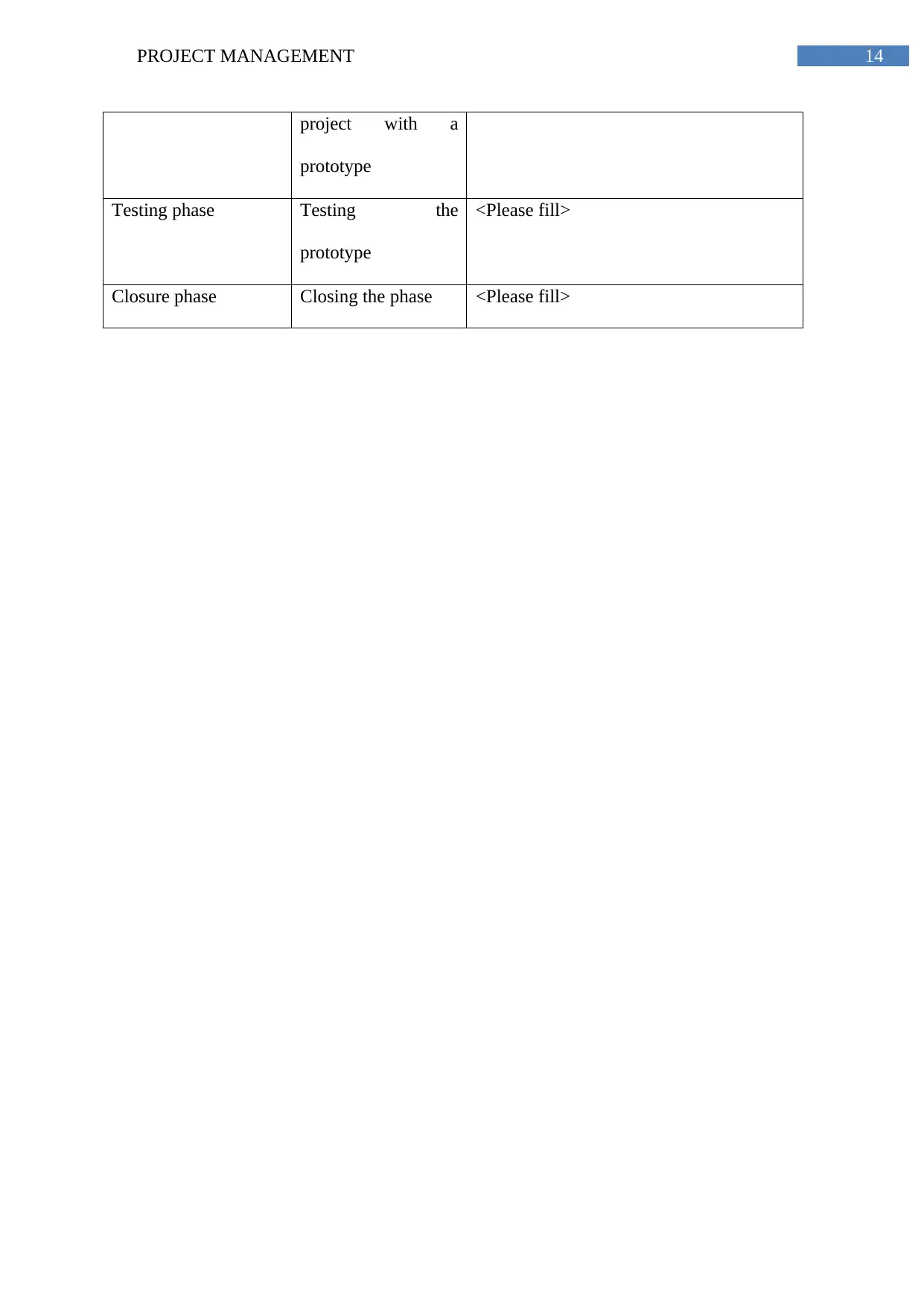
14PROJECT MANAGEMENT
project with a
prototype
Testing phase Testing the
prototype
<Please fill>
Closure phase Closing the phase <Please fill>
project with a
prototype
Testing phase Testing the
prototype
<Please fill>
Closure phase Closing the phase <Please fill>
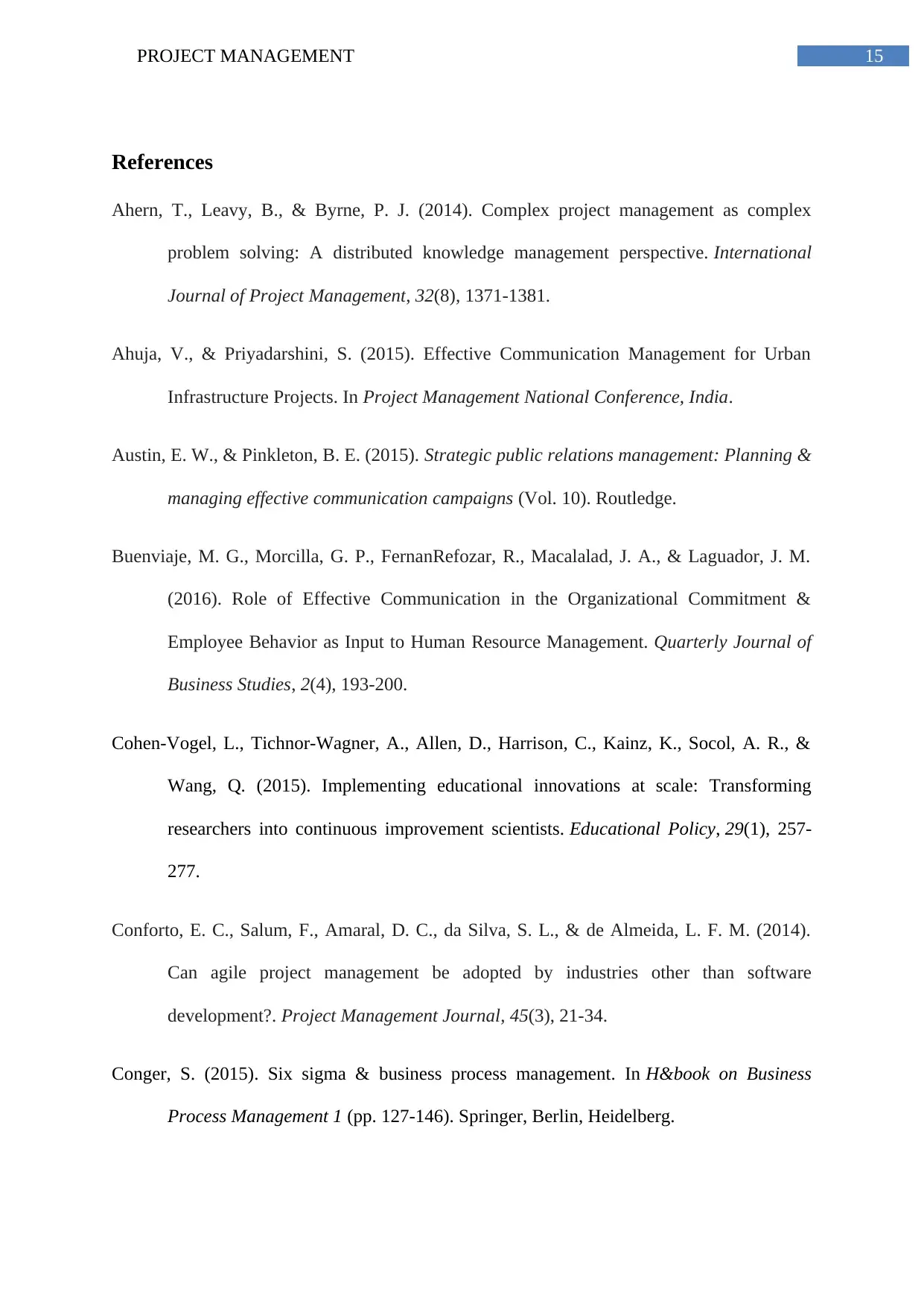
15PROJECT MANAGEMENT
References
Ahern, T., Leavy, B., & Byrne, P. J. (2014). Complex project management as complex
problem solving: A distributed knowledge management perspective. International
Journal of Project Management, 32(8), 1371-1381.
Ahuja, V., & Priyadarshini, S. (2015). Effective Communication Management for Urban
Infrastructure Projects. In Project Management National Conference, India.
Austin, E. W., & Pinkleton, B. E. (2015). Strategic public relations management: Planning &
managing effective communication campaigns (Vol. 10). Routledge.
Buenviaje, M. G., Morcilla, G. P., FernanRefozar, R., Macalalad, J. A., & Laguador, J. M.
(2016). Role of Effective Communication in the Organizational Commitment &
Employee Behavior as Input to Human Resource Management. Quarterly Journal of
Business Studies, 2(4), 193-200.
Cohen-Vogel, L., Tichnor-Wagner, A., Allen, D., Harrison, C., Kainz, K., Socol, A. R., &
Wang, Q. (2015). Implementing educational innovations at scale: Transforming
researchers into continuous improvement scientists. Educational Policy, 29(1), 257-
277.
Conforto, E. C., Salum, F., Amaral, D. C., da Silva, S. L., & de Almeida, L. F. M. (2014).
Can agile project management be adopted by industries other than software
development?. Project Management Journal, 45(3), 21-34.
Conger, S. (2015). Six sigma & business process management. In H&book on Business
Process Management 1 (pp. 127-146). Springer, Berlin, Heidelberg.
References
Ahern, T., Leavy, B., & Byrne, P. J. (2014). Complex project management as complex
problem solving: A distributed knowledge management perspective. International
Journal of Project Management, 32(8), 1371-1381.
Ahuja, V., & Priyadarshini, S. (2015). Effective Communication Management for Urban
Infrastructure Projects. In Project Management National Conference, India.
Austin, E. W., & Pinkleton, B. E. (2015). Strategic public relations management: Planning &
managing effective communication campaigns (Vol. 10). Routledge.
Buenviaje, M. G., Morcilla, G. P., FernanRefozar, R., Macalalad, J. A., & Laguador, J. M.
(2016). Role of Effective Communication in the Organizational Commitment &
Employee Behavior as Input to Human Resource Management. Quarterly Journal of
Business Studies, 2(4), 193-200.
Cohen-Vogel, L., Tichnor-Wagner, A., Allen, D., Harrison, C., Kainz, K., Socol, A. R., &
Wang, Q. (2015). Implementing educational innovations at scale: Transforming
researchers into continuous improvement scientists. Educational Policy, 29(1), 257-
277.
Conforto, E. C., Salum, F., Amaral, D. C., da Silva, S. L., & de Almeida, L. F. M. (2014).
Can agile project management be adopted by industries other than software
development?. Project Management Journal, 45(3), 21-34.
Conger, S. (2015). Six sigma & business process management. In H&book on Business
Process Management 1 (pp. 127-146). Springer, Berlin, Heidelberg.
Paraphrase This Document
Need a fresh take? Get an instant paraphrase of this document with our AI Paraphraser
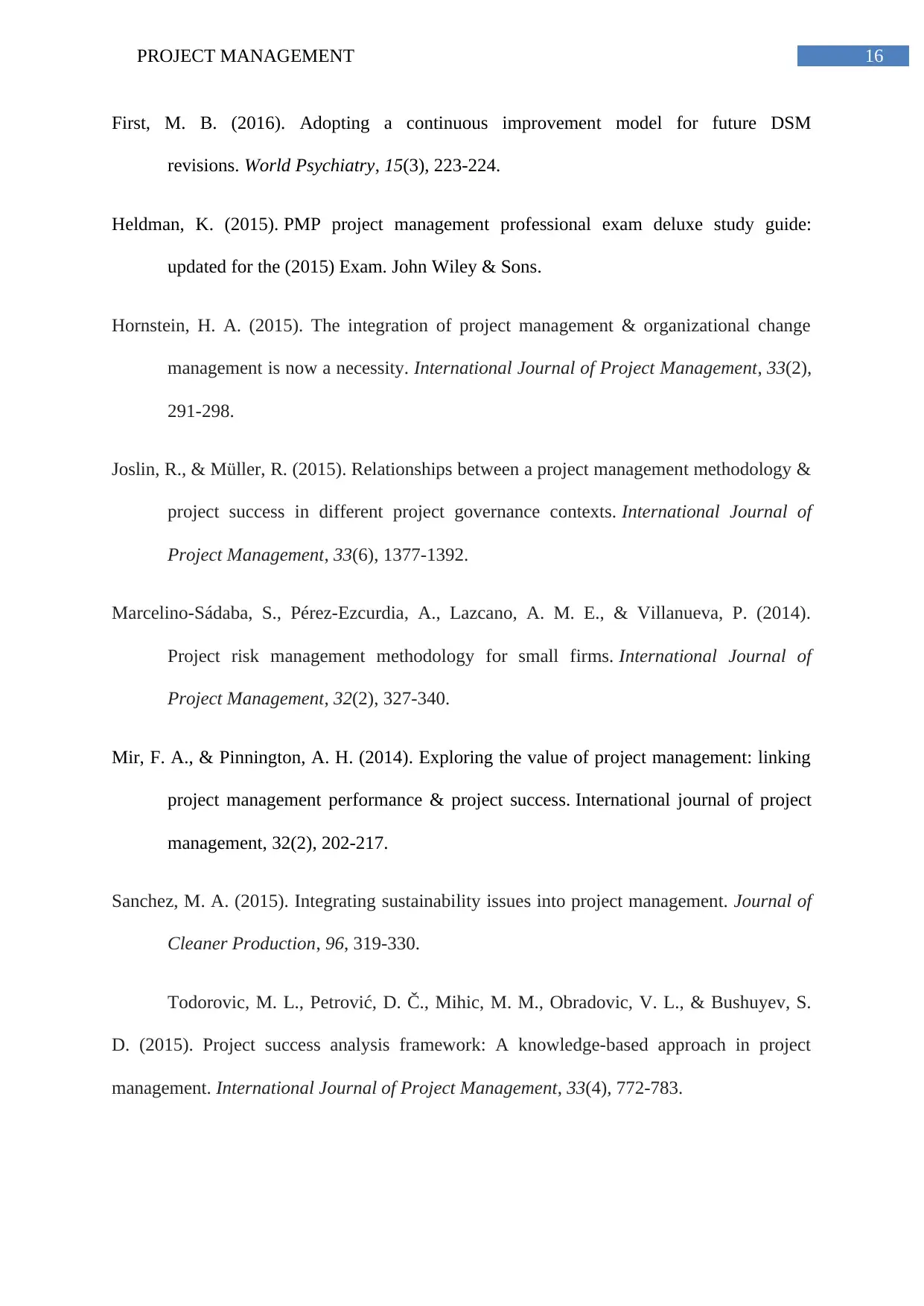
16PROJECT MANAGEMENT
First, M. B. (2016). Adopting a continuous improvement model for future DSM
revisions. World Psychiatry, 15(3), 223-224.
Heldman, K. (2015). PMP project management professional exam deluxe study guide:
updated for the (2015) Exam. John Wiley & Sons.
Hornstein, H. A. (2015). The integration of project management & organizational change
management is now a necessity. International Journal of Project Management, 33(2),
291-298.
Joslin, R., & Müller, R. (2015). Relationships between a project management methodology &
project success in different project governance contexts. International Journal of
Project Management, 33(6), 1377-1392.
Marcelino-Sádaba, S., Pérez-Ezcurdia, A., Lazcano, A. M. E., & Villanueva, P. (2014).
Project risk management methodology for small firms. International Journal of
Project Management, 32(2), 327-340.
Mir, F. A., & Pinnington, A. H. (2014). Exploring the value of project management: linking
project management performance & project success. International journal of project
management, 32(2), 202-217.
Sanchez, M. A. (2015). Integrating sustainability issues into project management. Journal of
Cleaner Production, 96, 319-330.
Todorovic, M. L., Petrović, D. Č., Mihic, M. M., Obradovic, V. L., & Bushuyev, S.
D. (2015). Project success analysis framework: A knowledge-based approach in project
management. International Journal of Project Management, 33(4), 772-783.
First, M. B. (2016). Adopting a continuous improvement model for future DSM
revisions. World Psychiatry, 15(3), 223-224.
Heldman, K. (2015). PMP project management professional exam deluxe study guide:
updated for the (2015) Exam. John Wiley & Sons.
Hornstein, H. A. (2015). The integration of project management & organizational change
management is now a necessity. International Journal of Project Management, 33(2),
291-298.
Joslin, R., & Müller, R. (2015). Relationships between a project management methodology &
project success in different project governance contexts. International Journal of
Project Management, 33(6), 1377-1392.
Marcelino-Sádaba, S., Pérez-Ezcurdia, A., Lazcano, A. M. E., & Villanueva, P. (2014).
Project risk management methodology for small firms. International Journal of
Project Management, 32(2), 327-340.
Mir, F. A., & Pinnington, A. H. (2014). Exploring the value of project management: linking
project management performance & project success. International journal of project
management, 32(2), 202-217.
Sanchez, M. A. (2015). Integrating sustainability issues into project management. Journal of
Cleaner Production, 96, 319-330.
Todorovic, M. L., Petrović, D. Č., Mihic, M. M., Obradovic, V. L., & Bushuyev, S.
D. (2015). Project success analysis framework: A knowledge-based approach in project
management. International Journal of Project Management, 33(4), 772-783.

17PROJECT MANAGEMENT
1 out of 18
![[object Object]](/_next/static/media/star-bottom.7253800d.svg)





